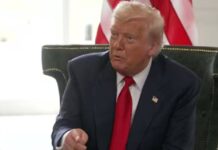
The radical Left is ill with Trump Derangement Syndrome. They only want to tear the President down.
That’s why Bill O’Reilly shredded a U.S. Senator for outrageously attacking Trump.
Recently, former Fox News host Bill O’Reilly sharply criticized Senate Minority Leader Chuck Schumer on his program, “No Spin News,” for labeling President Donald Trump’s trade agreement with the European Union as “fake.” O’Reilly aired a clip of Schumer’s Senate floor speech from Monday, where the senator challenged Trump’s assertion that the deal was the “biggest deal ever.” In a video uploaded to O’Reilly’s YouTube channel, he accused Schumer of outright deceit, claiming the senator was misrepresenting the facts of the agreement.
In the clip, Schumer stated, “Trump would have you believe it’s the ‘biggest deal ever,’ that’s his words, dangling $250 billion of new energy purchases and more in new investments. There’s just one hiccup – it’s fake.” O’Reilly countered, insisting, “No, it’s not. Schumer is lying. And I very rarely use that word. I usually say he’s misleading or he’s a propagandist, which he is. But he’s just lying. He’s just head down, reading something that’s been written for him by one of his propaganda people.”
O’Reilly, who noted he once had a cordial relationship with Schumer and occasionally encounters him in New York, expressed strong disapproval. “I have no respect for Charles Schumer. None. None. He doesn’t love this country, in my opinion. He’s not looking out for you or me or anybody else,” he said. “He is a rank propagandist. And again, I don’t use this kind of rhetoric, all right? I usually can see two sides to this story. You know that. This guy? Oof.”
On Monday, Schumer cited a Wall Street Journal report, which referenced analysts who argued that the European Commission President Ursula von der Leyen’s commitment to buy $250 billion in American energy annually for three years was unrealistic. The trade deal also includes a 15% tariff on most EU goods entering the U.S., a $600 billion EU investment in the U.S. economy by 2028, and significant purchases of American military equipment, per a White House fact sheet. Additionally, the EU will face 50% tariffs on steel, aluminum, and copper.
Trump Admin Reaching Deals More Favorable To American Workers And Companies
President Donald Trump’s trade policies, including the recent agreement with the European Union, aim to reshape global trade dynamics to favor American interests. The deal, announced in 2025, includes substantial commitments from the EU, such as $250 billion in annual energy purchases, $600 billion in investments by 2028, and increased procurement of U.S. military equipment. These measures are designed to boost American industries, create jobs, and reduce trade imbalances.
The imposition of a 15% tariff on most EU goods entering the U.S., alongside 50% tariffs on steel, aluminum, and copper, is a cornerstone of Trump’s approach. These tariffs aim to protect American manufacturers by making imported goods more expensive, thereby encouraging domestic production. According to a 2025 White House fact sheet, the tariffs are expected to incentivize EU investments in U.S. industries, particularly in manufacturing and energy, fostering economic growth and reducing reliance on foreign supply chains.
Critics, including Senate Minority Leader Chuck Schumer, have questioned the feasibility of the EU’s commitments, particularly the $250 billion energy pledge. Analysts cited in a 2025 Wall Street Journal report argue that the EU’s energy market dynamics and existing supply contracts may limit its ability to meet this target. However, supporters of the deal contend that even partial fulfillment of these commitments would significantly benefit U.S. energy producers, particularly in natural gas and renewable sectors, which have seen increased demand globally.
Trump’s trade strategy extends beyond the EU deal, building on his administration’s earlier efforts to renegotiate agreements like the USMCA (United States-Mexico-Canada Agreement). The USMCA, implemented in 2020, tightened rules of origin for automobiles, requiring 75% of components to be sourced from North America, up from 62.5% under NAFTA. This change aimed to bring manufacturing jobs back to the U.S. and reduce trade deficits with Mexico and Canada, which reached $81 billion and $20 billion, respectively, in 2024, according to U.S. Census Bureau data.
The EU deal’s investment component, with $600 billion pledged by 2028, is intended to stimulate job creation in key U.S. sectors like technology, infrastructure, and defense. A 2025 report from the U.S. Chamber of Commerce highlights that foreign direct investment (FDI) from the EU already supports over 4.7 million American jobs. The additional investment could further bolster employment, particularly in states like Texas and Ohio, where manufacturing and energy sectors are prominent.
Tariffs on steel, aluminum, and copper aim to revive domestic production in these industries, which have faced stiff competition from cheaper imports. The American Iron and Steel Institute reported in 2025 that U.S. steel production increased by 12% since 2020, partly due to earlier tariff measures. The 50% tariffs in the EU deal are expected to further strengthen this trend, though critics warn of potential retaliatory tariffs from the EU, which could affect U.S. agricultural exports like soybeans and pork.
The military equipment purchases outlined in the deal align with Trump’s push to expand U.S. defense exports. The EU’s commitment to buy American-made equipment, such as fighter jets and missile defense systems, supports companies like Lockheed Martin and Boeing. A 2025 report from the Defense Security Cooperation Agency notes that U.S. arms exports reached $238 billion in 2024, with Europe as a key market. This aspect of the deal not only strengthens U.S. defense industries but also deepens strategic ties with EU nations.
Trump’s trade policies have sparked debate over their long-term impact. Proponents argue that the tariffs and investment pledges create leverage for the U.S. to negotiate better terms in future deals, citing the EU’s willingness to engage despite initial resistance. A 2025 analysis by the Peterson Institute for International Economics suggests that Trump’s tariffs have increased U.S. GDP by 0.4% annually by incentivizing domestic production, though consumer prices for goods like electronics have risen by 2-3%.
By leveraging tariffs and securing investment commitments, the administration aims to reduce the U.S. trade deficit, which stood at $971 billion in 2024, according to the U.S. Department of Commerce. The EU deal, if successful, could serve as a model for negotiations with other trading partners, such as China and India, where similar tariff and investment strategies are being considered.



















